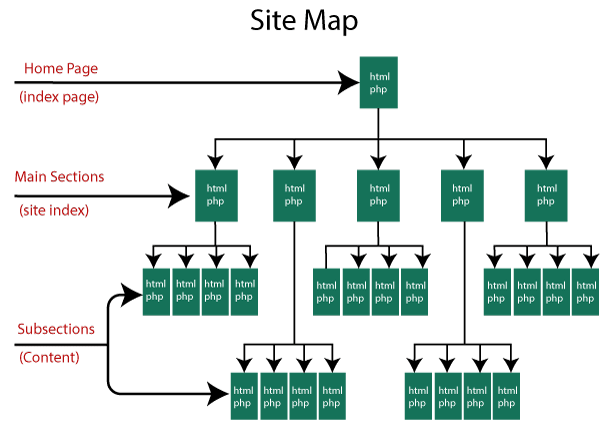minishortner.com what is site map for seo A sitemap is essentially a roadmap for your website, helping search engines like Google find and understand all of your pages and content more efficiently. It’s like a table of contents, but in a file format (.xml) that search engines can read and crawl.
minishortner.com what is site map for seo

- XML sitemaps: These are the most common type of sitemap and are used to list all of the pages on your website, along with additional information such as the last time the page was updated, how important it is relative to other pages on your site, and whether there are any alternate language versions.
- HTML sitemaps: These are less common than XML sitemaps, but they can be helpful for users to navigate your website. They are essentially just a regular webpage that lists all of the pages on your website, but they are designed for humans to read rather than search engines. minishortner.com what is site map for seo
minishortner.com what is site map for seo benefits?
- Improved website crawling and indexing: Sitemaps can help search engines find and index all of the pages on your website, even if they are not linked to from other pages. This can help to improve your website’s visibility in search results. minishortner.com what is site map for seo
- Increased website traffic: By making it easier for search engines to find your website, sitemaps can help to increase your website traffic.
- Improved user experience: HTML sitemaps can help users to find the information they are looking for on your website more easily.
Do you need a sitemap for your website?
If you have a small website with a few pages, you may not need a sitemap. However, if you have a larger website with many pages, or if you have a website that is not well-linked, then a sitemap can be helpful. minishortner.com what is site map for seo
How to create a sitemap: minishortner.com what is site map for seo
There are many online tools that can help you to create a sitemap for your website. You can also create a sitemap manually, but this can be time-consuming for large websites.
Once you have created your sitemap, you need to submit it to Google Search Console. This will help Google to find and index your sitemap. minishortner.com what is site map for seo
You asked for “more” about sitemaps for SEO, so I’m happy to dig deeper! What specifically would you like to know more about? Here are some potential areas I can delve into:
- Advanced sitemap features: We discussed basic elements like listing URLs, but there are deeper functionalities like prioritizing pages, indicating change frequency, and specifying alternate language versions. I can explain these in detail and their impact on SEO.
- Different types of sitemaps: Did you know there are specific sitemaps for images, videos, and news content? Understanding these specialized formats can help you optimize your non-text content for search engines.
- Common sitemap mistakes: Creating a sitemap isn’t always straightforward. I can share some common pitfalls to avoid and tips for ensuring your sitemap is accurate and effective.
- Tools and resources: Creating and submitting sitemaps can be technical. I can recommend handy tools and resources to simplify the process, whether you’re a coding whiz or a beginner.
- Beyond crawling and indexing: While sitemaps primarily help search engines crawl your website, I can explain how they can also indirectly benefit user experience and your overall SEO strategy.
Just let me know what catches your interest, and I’ll gladly provide more information about sitemaps and their role in SEO!
types of site map for seo
When it comes to SEO, minishortner.com what is site map for seo sitemaps act as treasure maps for search engines, guiding them to all the valuable content buried within your website. But not all maps are created equal, and in the realm of SEO, you’ve got two main types:
- XML Sitemaps:
Think of these as the blueprints for your website, written in a special language (XML) that search engines can understand. They list all your important pages, along with details like:
- URL: The web address of the page.
- Last modified: when the page was last updated.
- Change frequency: how often the page is likely to change (e.g., daily, weekly, monthly).
- Priority: How important the page is relative to others on your site.
XML sitemaps are invisible to human visitors, but they work their magic behind the scenes, helping search engines crawl and index your website efficiently. This can lead to:
- Improved website visibility: By making it easier for search engines to find all your pages, XML sitemaps can boost your website’s ranking in search results.
- Increased website traffic: More visibility often translates to more visitors finding their way to your website.
- Better user experience: A well-indexed website means users can easily find the information they’re looking for, leading to a more positive experience.
- HTML Sitemaps:
Imagine a user-friendly map hanging on your website’s wall, guiding visitors to different sections and pages. That’s the essence of an HTML sitemap. While not directly consumed by search engines, they offer several benefits:
- Enhanced navigation: HTML sitemaps provide a clear and concise overview of your website’s structure, making it easier for users to find what they’re looking for, especially on large or complex websites.
- Improved internal linking: By strategically linking to relevant pages within your HTML sitemap, you can encourage users to explore deeper into your website, boosting engagement and SEO.
- User-friendliness: Unlike XML sitemaps, HTML sitemaps are designed for human consumption, offering a more intuitive and visually appealing way to navigate your website.
Remember, both XML and HTML sitemaps have their own strengths and weaknesses. The ideal approach often involves using both:
- XML sitemap: Submit it to search engines to ensure efficient crawling and indexing.
- HTML sitemap: Include it on your website to improve user experience and internal linking.
By utilizing both types of sitemaps, you can create a well-charted path for both search engines and users, leading to a thriving online presence.
I hope this explanation, along with the visuals, provides a clearer understanding of the different types of sitemaps and their role in SEO. If you have any further questions, feel free to ask!
Determining the “best” sitemap for SEO depends on your specific website and goals. Both XML and HTML sitemaps have their strengths and weaknesses, and the ideal approach often involves incorporating both:
minishortner.com what is site map for seo of Strengths and Weaknesses?
XML Sitemap:
- Strengths:
- Efficiently communicates all important pages to search engines.
- Provides additional information like last update, change frequency, and page priority.
- Not visible to users, so it doesn’t clutter your website.
- Weaknesses:
- Not user-friendly for humans.
- Requires submission to search engines.
HTML Sitemap:
- Strengths:
- Clear and concise overview of website structure for users.
- Encourages deeper exploration through internal linking.
- Improves user experience and engagement.
- Weaknesses:
- Doesn’t directly impact search engine indexing.
- Requires careful design and maintenance.
Here’s a quick guide to help you decide:
- Small website: You might only need an XML sitemap, especially if user navigation is straightforward.
- Large or complex website: Both XML and HTML sitemaps are beneficial. XML helps search engines find everything, while HTML guides users effectively.
- Focus on SEO: Prioritize an XML sitemap for accurate indexing and ranking potential.
- Focus on user experience: An HTML sitemap can complement your SEO efforts by improving user engagement.
Ultimately, the best sitemap for SEO is the one that effectively serves both your users and search engines. By combining the strengths of XML and HTML sitemaps, you can create a well-charted path for online success.
If you have more information about your website and goals, I can provide a more personalized recommendation on the best type of sitemap for you.
Conclusion
In conclusion, sitemaps are not a magic bullet for SEO, but they are a valuable tool that can significantly improve your website’s visibility, user experience, and overall SEO performance. By employing both types strategically, you can create a winning combination for your online success.
FAQ’s minishortner.com what is site map for seo
1. What is a sitemap?
A sitemap is a file that lists all the important pages on your website, helping search engines like Google find and understand them better. It’s like a roadmap for your website, written in a language (XML) that search engines can understand.
2. Why are sitemaps important for SEO?
Sitemaps help search engines discover all your pages, even if they aren’t linked to from other pages. This can improve your website’s visibility in search results and potentially lead to more traffic. They also provide additional information like last update and change frequency, which can influence how search engines prioritize your pages.
3. Do I need a sitemap?
If you have a small website with a few pages, you probably don’t need a sitemap. However, if you have a larger website with many pages, or if you have pages that are not well-linked, then a sitemap can be helpful.
4. What are the different types of sitemaps?
There are two main types:
- XML sitemaps: Used for search engines and submitted to Google Search Console.
- HTML sitemaps: Used for users to navigate your website and displayed on your website.
5. How do I create a sitemap?
There are many online tools that can help you create a sitemap, such as Screaming Frog or Yoast SEO. You can also create a sitemap manually, but this can be time-consuming for large websites.
6. Where do I submit my sitemap?
Once you have created your sitemap, you need to submit it to Google Search Console. This will help Google find and index your sitemap.
7. Can a sitemap improve my website rankings?
Sitemaps alone cannot guarantee higher rankings, but they can make it easier for search engines to find and index your website, which can potentially lead to improved rankings.
8. Do I need to update my sitemap?
Yes, you should update your sitemap whenever you add or remove pages from your website.
9. What are some common mistakes with sitemaps?
- Not including all important pages.
- Submitting an outdated sitemap.
- Including pages that shouldn’t be indexed.
- Using incorrect formatting.
10. Can you recommend any resources for learning more about sitemaps?
- Google Search Central: https://developers.google.com/search/docs/crawling-indexing/sitemaps/build-sitemap
- Screaming Frog: https://www.screamingfrog.co.uk/xml-sitemap-generator/
- Yoast SEO: https://yoast.com/help/xml-sitemaps-in-the-wordpress-seo-plugin/
I hope this answers your most common questions about sitemaps for SEO! If you have any other questions, feel free to ask.

